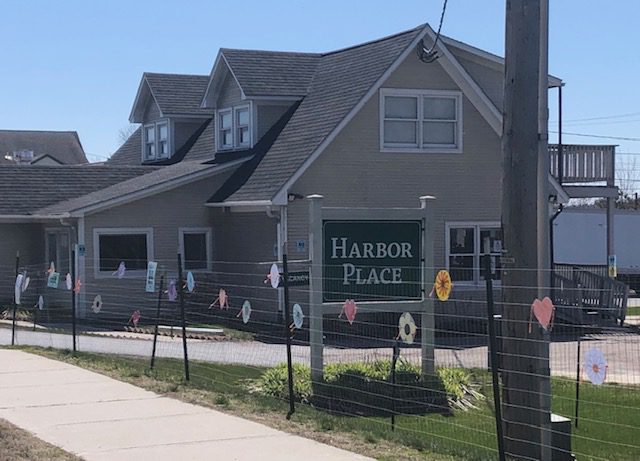
The Harbor Place motel in Burlington, Vt. Photo courtesy of Champlain Housing Trust
The homeless population has been one of the most vulnerable to COVID-19. Lack of access to clean water, sanitization, and health care, and living in close quarters such as homeless shelters and tent encampments where physical distancing is impossible, increase the probability that the disease will spread exponentially. Many already-strained organizations have been forced to act quickly to adjust to the mounting crisis.
Decongestion of the largest shelters, by spreading beds out in existing space and shifting some higher-risk people into motel units, has been a primary approach across the country, says Kate Speltz, a planner in the Housing, Homelessness and Community Development Division of King County in Washington state. King County pioneered such an approach. To do this, however, you need access to motel rooms. King County purchased a motel in early March, but in Burlington, Vermont, the state partnered with a community land trust that was already operating a motel as transitional housing to repurpose it as isolation housing.
The Champlain Housing Trust in Vermont is one of the many nonprofit housing and homeless-service providers that have stepped up to respond to these needs by quickly repurposing space to be able to quarantine.
The Champlain Housing Trust was founded in 1984 and is today the largest community land trust in the country. In addition to offering pathways to permanently affordable homeownership, managing affordable rental housing, and advocating for affordable housing across the state, the organization serves the area’s homeless population with transitional housing facilities and rehabilitation services. In mid-March, working with its partners in state government, the organization quickly adapted its Harbor Place emergency housing facility into isolation accommodations to safely house symptomatic homeless folks with nowhere else to turn.
“As the situation started heating up and the state started paying closer attention, we stepped up and said the quickest way to address the need [for isolation facilities] would be to move everyone out of Harbor Place and use the motel as somewhere we can layer in other services and keep symptomatic people in one place,” says Chris Donnelly, the director of community relations at Champlain Housing Trust. “We agreed to do this on Thursday morning, and by that night we had our first guest.”
Champlain Housing Trust purchased the Harbor Place motel for $1.8 million in 2013 to combat the rising cost of sheltering northwest Vermont’s housing insecure population. Driven by high costs and low vacancy rates, the area’s homeless population was continuing to surge. A healthy housing market hovers around a 5 percent vacancy rate; the Champlain region sits at around 1 percent. The state had been renting motel rooms to provide shelter to those in need, but with costs reaching up to $5 million a year, it became clear that a more economical solution was needed.
“We basically stepped in and said, ‘We can do it cheaper’ and add services to help folks get back on their feet and into housing,” Donnelly says. “So we purchased the Harbor Place motel for that purpose and were able to offer lower rates while creating the opportunity to have housing services on site.”
The nonprofit rents rooms at the 55-room property to the state and local hospital system at $42 per night, compared to the $120 per night that for-profit motels were charging. Harbor Place also offers services to residents, which among other things allow local health care facilities to keep track of former patients and better perform follow-up care. The Harbor Place model has saved around $575,000 per year for the state, and $1.5 million per year for the health care system.
But during COVID-19, the priorities became different, and CHT changed how Harbor Place was used practically overnight. Following the lead of states like Washington and California—which were dealing with the pandemic at an earlier date—the state determined it would need to quickly set up isolation facilities to house symptomatic homeless who were waiting for their test results. When the state approached CHT, the organization first offered to purchase another motel. Instead, the state requested that CHT move current asymptomatic guests out to other hotel rooms and repurpose the facility. This enabled the facility to be ready nearly instantly.
The first step was to move current residents of Harbor Place who weren’t exhibiting any symptoms to other nearby facilities. As of April 9, there were 1,400 available hotel rooms to house asymptomatic individuals across the region, and residents who didn’t need to be as carefully isolated were placed in one of those.
Then CHT altered the process for accepting new guests into the motel. Referrals now come from the Economic Services Department of the state of Vermont after a recommendation for isolation has been made by a medical provider—in CHT’s case, those recommendations are generally being made by the Community Health Centers of Burlington, its local Federally Qualified Health Center.
CHT purchased a vehicle that it has loaned to the Community Health Centers of Burlington (CHCB) so it can transport new guests directly to Harbor Place. CHCB also uses it to do outreach and testing for people who may have trouble getting to hospitals or testing sites.
As part of the transition, the state agreed to pay for an additional 15 rooms above the existing 30-room block, whether or not they get filled. According to Michael Monte, the organization’s chief operations and financial officer, the state’s commitment to cover 45 total rooms ensured that the CHT’s budget for Harbor Place operations would remain balanced, keeping the organization from taking any major financial hits once it transitioned into an isolation facility for the symptomatic.
The organization made some property improvements, including adding fencing to quell local residents’ fears that people with a highly contagious illness were staying in close proximity to them. The fencing does not actually prevent residents from leaving, but clearly delineates the space in which people who are isolating are expected to be.
In addition to these capital improvements, the organization also restructured the services being offered to its guests, emphasizing the need to remain sheltered in place. Harbor Place has ensured that guests are receiving three meals at their door each day, and have access to telemedicine services, plus a physician and nurse on-site. They can additionally place orders with the front desk for their pharmaceutical needs and are able to speak by phone with a social worker at least two or three times per day.
“Because we’ve been operating [a motel], we became the leaders for the rest of the state, simply because we were up and running really quickly,” says Monte, who primarily led Harbor Place’s transition into an isolation facility. “We had established protocols and roles [for processing and receiving folks into Harbor Place] and were quite ahead of the curve for the response, and that was a real relief for other parts of the state.”
Monte says the state’s quick move to create an isolation facility has likely played a role in keeping a widespread outbreak from occurring in the state so far. As of April 13, he said, the state had 630 people who have tested positive, “which is nothing like what you’re seeing in other places.” (As of June 1, there have been 952 confirmed cases of COVID-19 in that state.) In mid-May, the site began transitioning to a facility for asymptomatic people who have tested positive for COVID-19 and need shelter.
“There hasn’t been an outbreak in the homeless population because of the action people took quickly and without too much need for process before decisions got made,” says Donnelly, adding that they essentially rewrote the protocols for entry into the shelter to specifically focus on admitting those exhibiting COVID-19 symptoms. “The urgency made us operate differently. And while it was a little messy as a byproduct of the pace of this change—with lots of emails, many people shifting focus on a dime, and unknowns about the risks involved and how the community would respond—everyone within our organization rowing in the same direction made decisions much easier. We all saw an opportunity to do something meaningful.”
CHT’s response serves as a reminder of the importance of nonprofits being able to remain nimble in the wake of tragedy, shifting their normal duties to add services and staff to address an urgent matter. For example, CHT had to hire an additional staff person to coordinate efforts between state officials and the Community Health Centers of Burlington regarding isolation recommendations.
“We didn’t stop to ask how much this would all cost,” says Donnelly. Clearly the state covering every direct expense they are able to track for Harbor Place was the only way such a big shift would be possible, but still, she says, “there’s no great way yet to know how much of a budgetary impact this [change] will have. It may stretch out over years.”
As we head into the next phase of this pandemic—one in which officials all over the country are making plans to return to a new normal—community development leaders should remain ready and willing to respond quickly according to each community’s urgent needs, and the funders and partners should be prepared to let them.
“I think what we’ve learned is that sometimes you need to set aside process and just act,” says Donnelly.






Comments